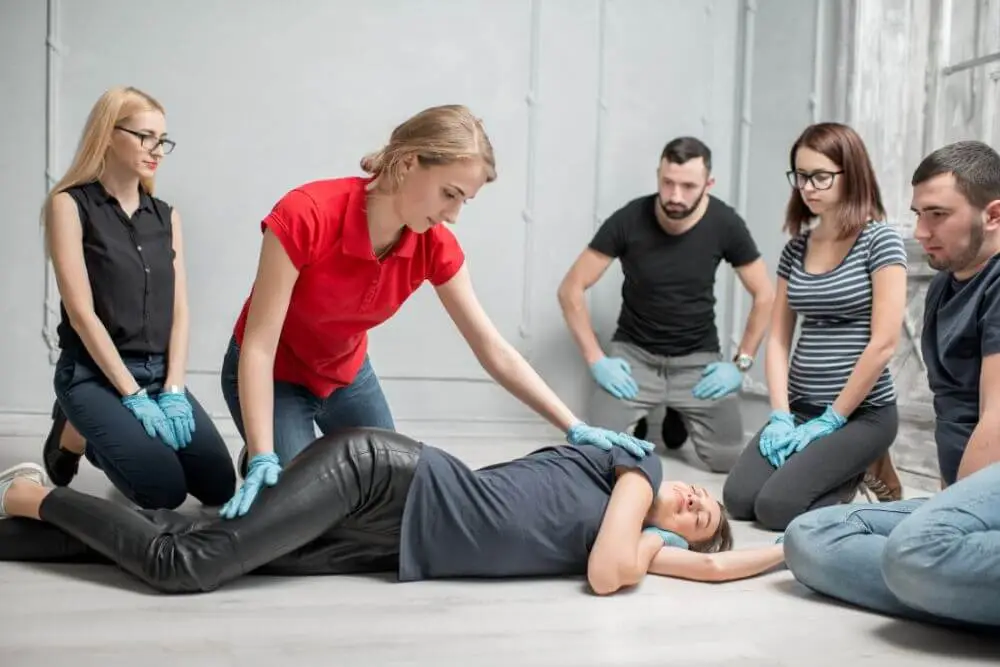First Aid At Work & Safe Use Of An AED Level 3
The Level 3 International Award in First Aid at Work and the Safe Use of an Automated External Defibrillator is a qualification aimed at providing candidates with the necessary knowledge, understanding and skills to support first aid and the use of a defibrillator in the workplace.
4.9 (8,746 Ratings)
Course Features
What you’ll learn
The Level 3 International Award in First Aid at Work and the Safe Use of an Automated External Defibrillator is a qualification aimed at providing candidates with the necessary knowledge, understanding, and skills to support first aid and the use of a defibrillator in the workplace.
Overview
Learners gaining this qualification will know basic emergency first-aid procedures and will be able to use a defibrillator correctly. The topics covered will help to maintain good practice in safe, prompt, and effective emergency first-aid treatment of individuals & much more.
Who Should Attend?
Centers are responsible for ensuring candidates can meet the necessary standard of language in which the course is being delivered.
1 Understand the role and responsibilities of a first aider
- State the role and responsibilities of a first aider
- Identify how to minimize the risk of infection to yourself and others
- Identify recommended first aid kit content requirement
2 Know how to assess an incident
- Conduct a scene survey
- Conduct a primary survey of a casualty
- Call for help to support a casualty
- Conduct a head to toe survey
3 Be able to manage an unresponsive casualty who is breathing normally
- Assess a casualty’s level of consciousness
- Open a casualty’s airway and check breathing
- Place an unresponsive casualty in the recovery position
- Manage a casualty who is in seizure
4 Know how to manage a casualty who is not breathing normally and unresponsive
- Identify when cardio pulmonary resuscitation is needed
- Demonstrate cardio pulmonary resuscitation using a manikin
5 Know how to recognize and assist a casualty who is choking
- Identify the signs of a partially and completely blocked airway
- Demonstrate first aid for a partially and completely blocked airway
6 Know how to recognize and assist a casualty with a minor injury
- Identify the different types of external bleeding
- Demonstrate first aid for controlling external bleeding
- Demonstrate first aid for a casualty with small cuts, grazes and bruises
7 Know how to manage a casualty who is in shock
- Identify the typical signs and symptoms of shock
- Demonstrate first aid for a casualty who is in shock
8 Know how to administer first aid to a casualty with injuries to bones, muscles and joints
- Recognize suspected fractures, dislocations and sprains and strains
- Demonstrate first aid for a casualty with a fracture, dislocation and sprain/strain
9 Know how to administer first aid to a casualty with suspected head and spinal injuries
- Recognize suspected concussion, skull fracture, cerebral compression and spinal injury
- Demonstrate first aid for a casualty with a suspected concussion, skull fracture, cerebral compression and spinal injury
10 Know how to administer first aid to a casualty with suspected chest injuries
- Recognize different types of chest injury
- Administer first aid for a chest injury
11 Know how to administer first aid to a casualty with burns and scalds
- Recognize factors that could affect the severity of a burn and scald
- Demonstrate first aid for burns involving dry heat, wet heat, electricity and chemicals
12 Know how to administer first aid to a casualty with an eye injury
- Give examples of common eye injuries
- Administer first aid for eye injuries involving dust, chemicals and embedded objects
13 Know how to administer first aid to a casualty with sudden poisoning
- Identify the routes that poisons can take to enter the body
- Administer immediate first aid to a casualty affected by sudden poisoning
- Identify sources of information for treating those affected by sudden poisoning
14 Know how to administer first aid to a casualty with anaphylaxis
- Identify common triggers for anaphylaxis
- Recognize signs and symptoms of anaphylaxis
- Administer immediate first aid for a casualty suffering from anaphylaxis
15 Know how to provide first aid to a casualty with suspected major illness
- Recognize signs and symptoms for a casualty suffering from a heart attack, stroke, epilepsy, asthma and diabetes
- Demonstrate first aid for a casualty suffering from major illnesses including heart attack, stroke, epilepsy, asthma and diabetes
16 Know how to safely use an automated external defibrillator (AED)
- Describe the differences between using an AED on an adult and child
- Identify safety considerations when using an automated external defibrillator
- Demonstrate the correct placement of AED electrode pads on a manikin
- Follow AED voice prompts accurately
- Demonstrate how to combine the use of an automated external defibrillator with minimal interruptions in cardiopulmonary resuscitation using a manikin
- Demonstrate the safe delivery of AED shock
- State the procedures if the casualty shows signs of life and starts to breath normally
- Identify the information required when handing over the casualty
The qualification is assessed using the HABC assessment pack and is split into two parts:
Part One: This component is assessed through practical demonstration of first aid skills.
Part Two: This knowledge based assessment requires learners to answer a series of short answer questions via written or oral responses.
100% Satisfaction Guarantee
We understand that safety is paramount for any organization. That’s why we guarantee 100% satisfaction with our services and products.
Lifetime Support
We provide lifetime support and assistance to our valued customers. Our team is available 24/7 to offer help and guidance whenever needed.
Expertise and Knowledge
We have a team of highly experienced and knowledgeable professionals who can provide expert advice on safety related issues.
Related Courses
In addition to the topics covered in this course, many other related courses can provide additional information and resources. Here are some popular ones.
Emergency First Aid, Defibrillation and CPR Level 2
International Award In Emergency First Aid At Work Level 2
Basic Life Support and the Safe Use of an AED Level 2
12+
Years Of Experience
15K+
Qualified Students
10+
Certified Trainers
100+
Courses & Programs
Testimonials
What Students are Saying
Check out our students’ testimonials and know how our institution has created a mark in the arena of professional education & training.
The Future Belongs To Those Who See Possibilities Today
At Safety Institute Pakistan, we understand the importance of preparing for the future. We strive to provide our students with quality education and training that will equip them with the skills and knowledge needed to be successful in their fields.
We are dedicated to helping our students find career success, so they can positively contribute to society. With our courses and qualifications, we are sure that you will be able to find success in your career path.








